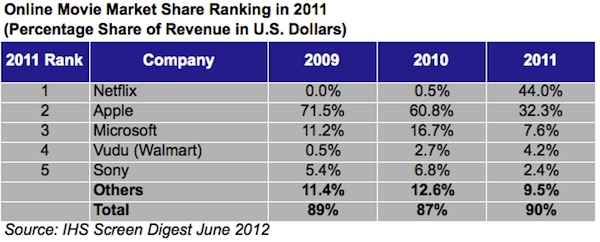 IHS announced it reckons that Netflix surged past Apple to become the largest U.S. online movie service in 2011.
IHS announced it reckons that Netflix surged past Apple to become the largest U.S. online movie service in 2011.
For more information visit: www.isuppli.com
Unedited press release follows:
Netflix Surpasses Apple to Take Lead in U.S. Online Movie Business in 2011
El Segundo, Calif., June 1, 2012 — Riding a tidal wave of growth for subscription video on demand (SVOD), Netflix Inc. in 2011 surged past Apple Inc. to become the largest U.S. online movie service in revenue terms, according to a new IHS Screen Digest Broadband Media Market Insight Report from information and analytics provider IHS (NYSE: IHS).
Netflix’s share of U.S. online movie revenue soared to 44 percent in 2011, up from less than 1 percent in 2010, as presented in the table below. The caused the company to rise to first place in 2011. Meanwhile, Apple’s share of total revenue declined to 32.3 percent last year, down from a 60.8 percent in 2010, despite enjoying strong revenue growth.
“2011 marked a sea change in the online movies business that saw the balance of consumer spending shift from a DVD-like transactional model to more TV-like subscription approach,” said Dan Cryan, research director for digital media at IHS. “The online movie business more than doubled in 2011 to reach $992 million and it is expected to double this year as well.”
Online, on the money
In the United States, revenue from SVOD services—which give consumers access to movies in return for a regular, recurring fee—reached $454 million in 2011, growing by more than 10,000 percent from $4.3 million in 2010. As a result, SVOD became the largest segment of the U.S. online movie business in 2011, surpassing the other major parts of the market, transactional VOD and electronic sell-through. This change can be attributed to two factors: Netflix’s decision to start charging directly for online access, and the major growth in the number of people using online SVOD.
Meanwhile, transactional VOD expanded to $273 million in 2011, up 75 percent from $155 million during 2010. In contrast to SVOD, transactional VOD services like iTunes require consumers to pay a separate fee to rent each individual movie. EST grew by just 2.4 percent to reach $236 million.
“We are in the midst of a significant change in the way people pay to consume movies online,” Cryan said. “All the significant growth in revenue in the U.S. online movie business in 2011 was generated by rental business models, which provide temporary access, not permanent ownership. Rental delivers unlimited consumption with a low monthly fee for older titles as well as cheap rentals of new releases, providing the kind of value that online consumers want. In contrast, EST, which is much more profitable for studios on a per-transaction basis, is stuck in the doldrums.”
Netflix and Apple leading two sides of the market
What Netflix and iTunes have in common is that both services are focused on the hardware side of the business.
Netflix is available on a very wide range of connected devices, while iTunes can take advantage of Apple’s soaring device sales growth.
Nevertheless, comparisons between the two services have their limits. IHS research reveals that it’s not unusual for 70 to 80 percent of titles consumed through a transactional service to be new releases. However, SVOD services are overwhelmingly used for older titles.
“Effectively the market has split,” Cryan said. “Netflix and Apple are competing for some of the same consumer time and money. However, the core value proposition of the two services is actually very different.”
To understand the relative positioning of Netflix and Apple, it’s revealing to compare each service to its closest competitor.
While Netflix rules the SVOD market, its closest competitor—Hulu—is less than 10 percent of its size. Apple’s iTunes continues to dominate the transactional segment, accounting for 63.0 percent of revenue in this area, which was only down slightly from 64.6 percent in 2010. At the same time, the big growth story of 2011 was Walmart’s Vudu, which captured 8.2 percent of the growing transactional market, up from 2.8 percent last year. Most of this growth has been achieved by using a Netflix-like device strategy and has come at the expense of other providers, not Apple.
SVOD into the future
The stunning growth in SVOD revenue seen in 2011 is not likely to continue at the same rate in the future.
Netflix’s customer transition is now complete. And while its effect will be felt into 2012, which will be the first full year of paid streaming, Netflix’s U.S. digital customer base is likely to expand at a slower rate, in keeping with premium pay-TV channels. Consequently, IHS expects transactional VOD to experience stronger growth than SVOD after 2012 unless there is a significant market entry, such as a standalone HBO streaming subscription or a full-fledged pay-TV subscription service delivered over the open Internet.
About IHS (www.ihs.com)
IHS (NYSE: IHS) is the leading source of information, insight and analytics in critical areas that shape today’s business landscape. Businesses and governments in more than 165 countries around the globe rely on the comprehensive content, expert independent analysis and flexible delivery methods of IHS to make high-impact decisions and develop strategies with speed and confidence. IHS has been in business since 1959 and became a publicly traded company on the New York Stock Exchange in 2005. Headquartered in Englewood, Colorado, USA, IHS employs more than 5,500 people in more than 30 countries around the world.
